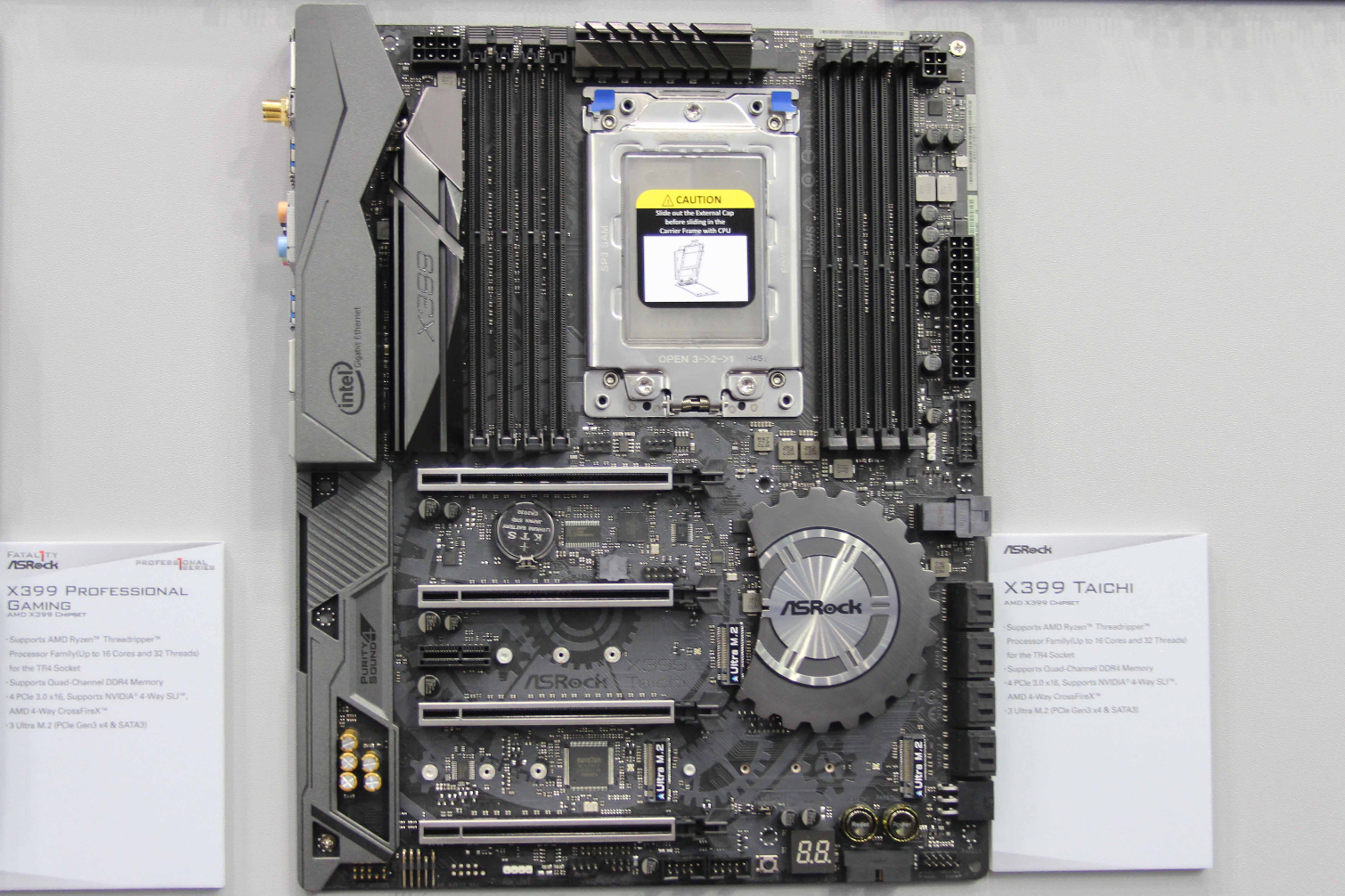AMD Announces Ryzen Threadripper, Challenges Intel With 12C/16C For $799 and $999
Enthusiasts have yearned for a suitable high-end desktop platform alternative for ages, and now we finally have one. AMD announced its highly anticipated Ryzen Threadripper in two flavors: The 1950X weighs in with 16 cores and 32 threads for $999, and the Threadripper 1920X brings 12 cores and 24 threads for $799. Both will ship in early August. AMD also announced its Ryzen 3 models and a ship date of July 27, but hasn't provided pricing information about these low-end models.
AMD released a video that outlines the basics of the launch and pits both Threadripper models against Intel's Core i9-7900X in a Multi-Threaded Cinebench R15 workload. The Ryzen Threadripper models win handily. That's a nice result, and it's noteworthy that both AMD models have the core count advantage, but the processors fall in the same price range. Given that Intel's 12-core and 16-core models aren't available yet, this is the closest we can get to a fair comparison to Intel's high-end models.
AMD's strategy has been to offer disruptive price points compared to competing Intel chips, and Threadripper's pricing continues that trend. Intel's competing Core i9-7960X features a similar 16C/32T as the $999 Threadripper 1950X, but it retails for $1,699. The $1,199 Core i9-7920X contends with the $799 12C/24T Threadripper 1920X.
Intel's realigned pricing for the Skylake-X processors was quite the buzz, but while the company has obviously reworked its high-end desktop pricing structure, it wasn't enough to stave off the underdog entirely. AMD's comparable products undercut Intel's Skylake-X models by $700 and $400, respectively, which is definitely going to fuel increased competition in the high-end desktop market, which has long been Intel's self-described high-margin lineup.
AMD released precious few details outside of pricing and frequencies. The Threadripper 1950X has a base 3.4GHz frequency that boosts to 4.0GHz under load. Current Ryzen models feature a two-core boost, and we expect that will continue. However, we have no information on XFR frequencies, which is an extra boost if your thermal solution is beefy enough, but we expect it to fall within the same 100-200MHz window we see with the existing models. Given the dual-die architecture, the 1950X almost certainly has 32MB of L3 cache, but AMD hasn't confirmed details.
The Threadripper 1920X features a 3.5GHz base and 4.0GHz boost. Intel hasn't released frequencies for its two competing chips, but it's pretty predictable. Intel's frequencies decline as the company adds more cores, and the 10C/20T Core i9-7900X features a 3.3GHz base. That means all of Intel's more well-endowed chips will have lower base frequencies. Both Threadripper processors will have higher base frequencies, partially offsetting some of Intel's IPC advantage. However, Intel's boost frequencies were one of the most surprising aspects of the Core i9 lineup. Intel's high core count models all boost to 4.5Ghz, and though we can't be sure of the unannounced turbos of the -7960X and -7920X, Intel might hold the advantage.
AMD's high-end models come without a cooler, and we expect the same trend for the Threadripper models. That's in-line with Intel's policy, too, so those extra costs are similar for both lineups. However, AMD employs solder while Intel stubbornly sticks to thermal paste, much to the ire of enthusiasts. We've tested the Core i9-7900X and found significant problems with the thermal paste, and we expect that to continue with Intel's higher core count models. AMD will likely have a higher TDP, though, so it will be interesting to see how it pans out when the chips hit our labs.
Get Tom's Hardware's best news and in-depth reviews, straight to your inbox.
We don't know much else about the Threadripper lineup other than existing information. We do know the chips drop into the massive 4,094-pin TR4 socket with the X399 chipset. That's the same socket AMD uses for its EPYC data center lineup, and it dwarfs Intel's 2,066-pin LGA2066 socket. AMD has long held the advantage when it comes to motherboard pricing, and though the X299 platform can be characterized as anything but cheap, AMD's TR4 socket might lead to a similar price range. Simply put, larger sockets are more expensive.
The Threadripper lineup will come armed with quad-channel memory, which is a notable advantage Intel's X99 (and now X299) platform holds over the cheaper Ryzen 7 models. That should even the playing field. Intel also has its 18/36 Core i9-7980XE in reserve, which lends the company the core count advantage, and a much broader product stack with five models with varying core/thread counts. Neither of those advantages mean much if there is a comparable platform with much cheaper alternatives. AMD also has an overwhelming PCIe advantage with a total of 60 lanes, while Intel has varying PCIe allotments that are markedly lower across the board.
Ryzen 3
AMD also announced that the Ryzen 3 lineup is shipping on July 27. The Ryzen 3 1300X weighs in with four cores and four threads with a 3.5/3.7GHz base/boost, while the Ryzen 3 1200 features the same core/thread count at 3.1/3.4GHz. These chips will do battle with Intel in the low end of the market, which is perhaps the largest volume segment. Intel holds the advantage of its integrated graphics, which becomes more important as we travel down the stack to models that aren’t usually accompanied by discrete graphics cards.
However, we expect the same brutal pricing model from AMD, so competition will be pitched for the low end of the enthusiast segment. Intel hasn't readjusted its pricing on the low-end models, but now that AMD is squeezing the entire desktop spectrum, we could see a reaction.

Paul Alcorn is the Editor-in-Chief for Tom's Hardware US. He also writes news and reviews on CPUs, storage, and enterprise hardware.
-
ClusT3R The only that Zen architecture needs is the dev community start playing with the architecture and legacy programs start using the benefits of the new architecture.Reply -
wiyosaya Replybut we expect it to fall within the same 100-200GHz window
I am sure that MHz in this sentence was intended. -
Paul Alcorn Reply19935316 said:but we expect it to fall within the same 100-200GHz window
I am sure that MHz in this sentence was intended.
Thanks, Fixed!
-
Aspiring techie Reply
What? I've always wanted a 200GHz CPU :)19935316 said:but we expect it to fall within the same 100-200GHz window
I am sure that MHz in this sentence was intended.
-
jowen3400 That is what the I9 should have started it. It is not that much faster than x99, insome cases it is worst. Heat is one that comes to mind.Reply -
Brian_R170 $799 and $999 seems like bad news for AMD shareholders. The margins have to be lower than 6/8-core Ryzen parts.Reply -
bit_user ReplyAMD released a video that outlines the basics of the launch and pits both Threadripper models against Intel's Core i9-7900X in a Multi-Threaded Cinebench R15 workload.
Man, they better hope Maxon doesn't decide to add some AVX optimizations in Cinebench. -
drumbum "...now that AMD is squeezing the entire desktop spectrum..."Reply
How great was it to write that!?!
Regardless of which team you root for, that's gotta be a great thing to hear finally. It certainly put a smile on me!


